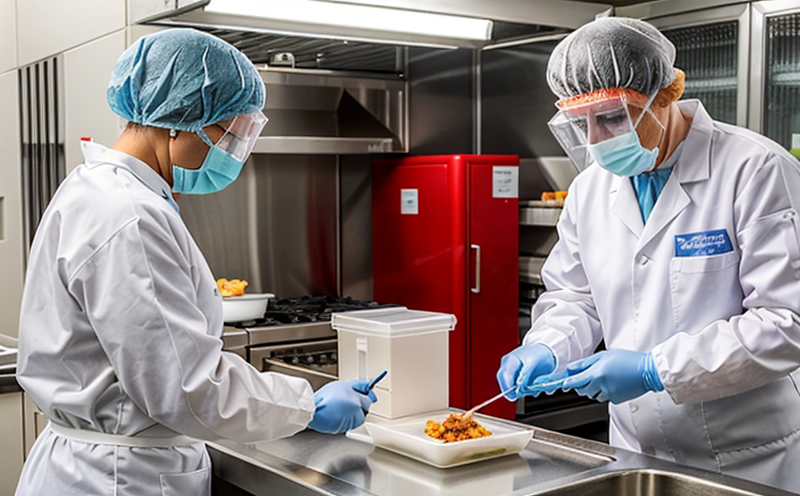USDA MLG 19.01 Detection of Viral Contaminants in Meat Products
The USDA MLG 19.01 method is a critical tool for ensuring the safety and quality of meat products by detecting viral contaminants that could pose significant health risks to consumers. This method, based on quantitative real-time polymerase chain reaction (qPCR), provides accurate and reliable detection levels down to as low as 5 plaque-forming units per gram (PFU/g) in various food matrices.
The primary goal of this testing procedure is to safeguard public health by identifying viral pathogens that can contaminate meat products during processing, storage, or distribution. Common viruses tested under USDA MLG 19.01 include Norovirus, Rotavirus, and Hepatitis A. These viruses are particularly concerning because they can cause severe gastrointestinal illness and have the potential to spread rapidly in food service environments.
To achieve accurate results, proper sample preparation is crucial. This involves homogenizing the meat product using a sterile buffer solution to release any viral contaminants present. The extracted nucleic acid from these samples is then subjected to qPCR amplification under controlled conditions. The presence of specific viral sequences is detected through fluorescence-based detection technology, providing quantifiable results.
The significance of this test cannot be overstated in the context of food safety and public health. By implementing USDA MLG 19.01, laboratories and processors can ensure that their products meet stringent regulatory requirements set forth by both national and international standards such as FDA, EU Food Law (Regulation EC/2073), and ISO/IEC 17025.
The method is particularly useful for identifying potential contamination points in the supply chain. For instance, it helps in tracing back to raw materials used during processing or assessing the effectiveness of sanitation protocols. Additionally, this testing can be instrumental in outbreak investigations where rapid detection and identification of pathogens are essential.
| Sample Type | Viral Pathogen |
|---|---|
| Muscle Meat | Norovirus |
| Poultry Products | Rotavirus |
| Fish and Seafood | Hepatitis A Virus |
The USDA MLG 19.01 method is not only beneficial for meat processors but also extends to other sectors like food service providers, retail chains, and suppliers of raw materials. By adhering to this protocol, these stakeholders can enhance their reputation as reliable partners in the global food industry.
In summary, USDA MLG 19.01 plays a vital role in safeguarding public health by detecting viral contaminants in meat products efficiently and accurately. Its implementation ensures compliance with regulatory standards while providing valuable insights into potential contamination risks within the supply chain.
Why Choose This Test
- Precision: Quantitative real-time PCR provides accurate measurements down to 5 PFU/g.
- Rapid Results: Short turnaround times for processing and reporting results.
- Compliance: Meets FDA, EU Food Law (Regulation EC/2073), and ISO/IEC 17025 standards.
- Detection of Multiple Viruses: Capable of identifying Norovirus, Rotavirus, and Hepatitis A.
- Potential for Outbreak Prevention: Helps trace back to sources of contamination and prevent further spread.
- Supply Chain Assurance: Ensures the integrity of raw materials used in meat processing.
Customer Impact and Satisfaction
The implementation of USDA MLG 19.01 has a direct impact on customer satisfaction by ensuring that meat products are safe for consumption. This method helps processors maintain their reputation as reliable suppliers, thereby enhancing consumer trust in the brand.
By detecting viral contaminants early in the supply chain, companies can take corrective actions promptly to prevent contamination from spreading further downstream. This proactive approach not only protects public health but also reduces financial losses associated with recalls and litigation.
Customers who choose laboratories offering this service benefit from peace of mind knowing that rigorous testing protocols are in place. They receive transparent reports detailing the results of each analysis, which can be used for internal quality assurance purposes or shared with regulatory bodies upon request.
Use Cases and Application Examples
- Supplier Verification: Testing raw materials before they enter the production line to ensure they meet required safety standards.
- Processing Plant Monitoring: Regularly sampling finished products to monitor for any signs of contamination during processing.
- Outbreak Investigations: Identifying specific viral strains responsible for foodborne illnesses and tracing back to their source.
- Quality Assurance Programs: Implementing ongoing testing programs as part of a comprehensive quality management system.
| Use Case | Description |
|---|---|
| Supplier Verification | Testing raw materials for Norovirus, Rotavirus, and Hepatitis A before processing begins. |
| Processing Plant Monitoring | Sampling finished products at various points in the production process to ensure no viral contaminants are present. |
| Outbreak Investigations | Identifying specific viral strains involved in foodborne illness outbreaks and tracing back to their source within the supply chain. |
| Quality Assurance Programs | Incorporating regular testing into existing quality assurance programs as part of a continuous improvement strategy. |
The USDA MLG 19.01 method is widely used across different industries, including meat processing, food service providers, and retail chains. It plays a crucial role in maintaining the highest standards of hygiene and safety within these sectors.





